Business Law Report: UK Legal System, Corporate Structure, and Laws
VerifiedAdded on 2023/02/02
|17
|5580
|67
Report
AI Summary
This report provides a comprehensive overview of UK business law, starting with an introduction to the sources of law, including legislation, EU directives, case laws, and international treaties. It details the laws organizations must comply with, such as the Companies Act 2006, employment law, health and safety law, consumer law, and competition law, and explains the government's role in lawmaking through the parliamentary procedure. The report then analyzes the application of statutory and common law, illustrating the impact of company, contract, and employment law on business operations. Furthermore, the report delves into specific legal solutions to business problems, comparing them with alternative dispute resolution, and concludes with a comparison of the legal systems of India and the UK, particularly focusing on foreign investment and currency regulations.
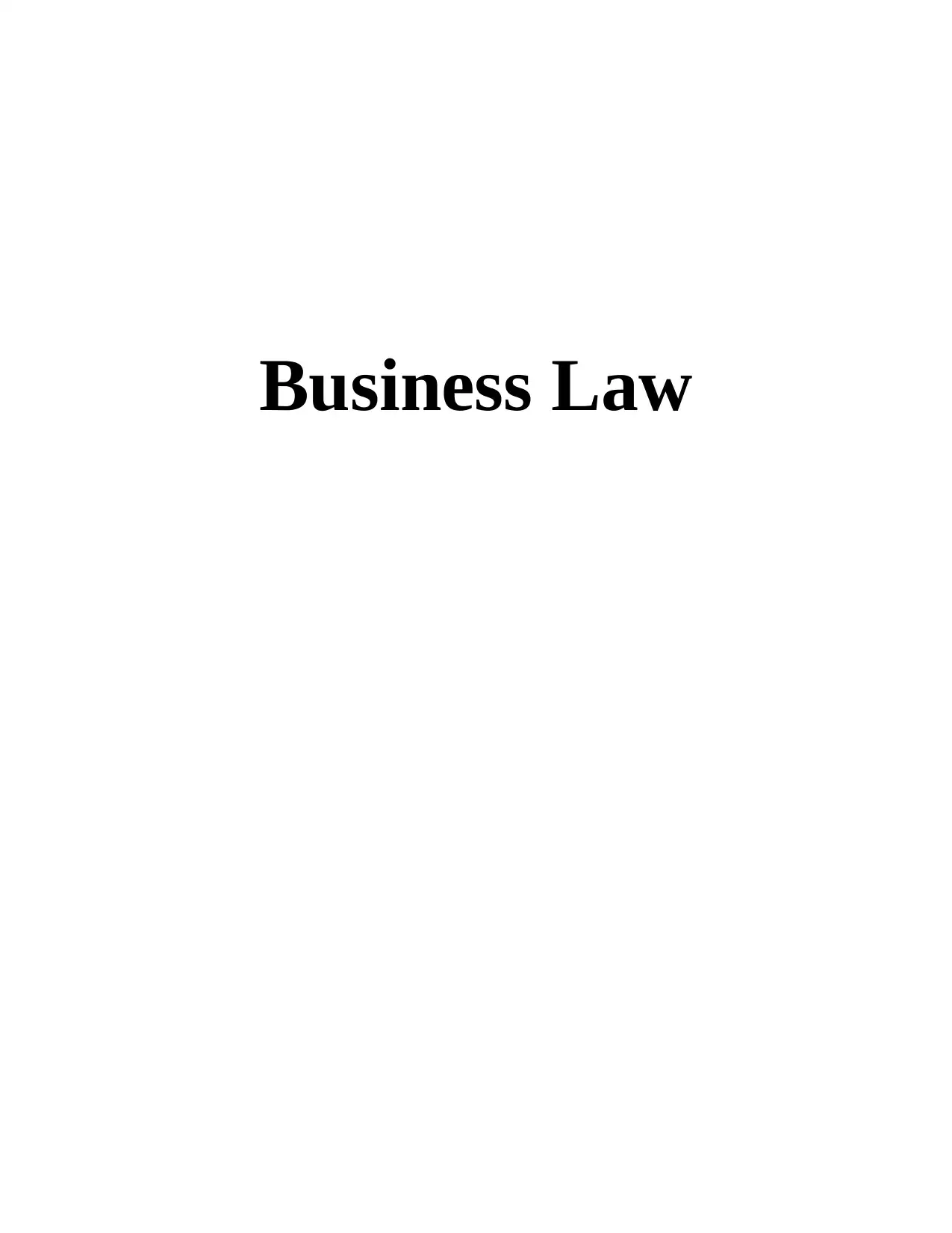
Business Law
Paraphrase This Document
Need a fresh take? Get an instant paraphrase of this document with our AI Paraphraser

Table of Contents
INTRODUCTION...........................................................................................................................2
ACTIVITY 1....................................................................................................................................3
1. Presenting Different sources of law, Laws an organisation must comply with, Role of
government in making law and Application of Statutory and common law.........................3
2. Application of Statutory and common law and Evaluation of effectiveness of the legal
system in context of recent development and reform.............................................................6
3. Difference between legislation, regulations and standards and their potential impact on
businesses, Critical evaluation and Effectiveness of legal system and law ..........................8
4. Appropriate legal solutions to range of business problems and their evaluation and
comparison.............................................................................................................................9
ACTIVITY 2..................................................................................................................................10
Corporate legal structure and employment legislation and law related to India..................11
Comparison of legal system of India and UK......................................................................13
CONCLUSION..............................................................................................................................13
REFERENCES..............................................................................................................................15
2
INTRODUCTION...........................................................................................................................2
ACTIVITY 1....................................................................................................................................3
1. Presenting Different sources of law, Laws an organisation must comply with, Role of
government in making law and Application of Statutory and common law.........................3
2. Application of Statutory and common law and Evaluation of effectiveness of the legal
system in context of recent development and reform.............................................................6
3. Difference between legislation, regulations and standards and their potential impact on
businesses, Critical evaluation and Effectiveness of legal system and law ..........................8
4. Appropriate legal solutions to range of business problems and their evaluation and
comparison.............................................................................................................................9
ACTIVITY 2..................................................................................................................................10
Corporate legal structure and employment legislation and law related to India..................11
Comparison of legal system of India and UK......................................................................13
CONCLUSION..............................................................................................................................13
REFERENCES..............................................................................................................................15
2

INTRODUCTION
The business law can be defined as set of various laws and legislations along with
specific regulations and standards which governs the operations of the entire business
organisation falling under the English legal system. These laws provide guidance to the business
man to set the flow of business in legal directions. They also define that what constitutes non
abidance and legal consequences of the same. The business law includes legislation such as
Employment rights act 1998, Health and safety act, 1974, Equality act, 2010 and many more.
In the present report, a detailed discussion over the laws and legislation applicable to the
business organisations is carried out. This includes determining the sources of law, the range of
legislation which affects the businesses in UK. Along with this how laws are made and
application of common and statutory law is done is outlined. Moreover, impact of employment,
contract and company law of organisation is defined with presenting examples. The effectiveness
and critical evaluation of legal system and law is presented as well. With this. Two examples are
taken to a give legal solution under the legal system and compared with the alternative dispute
resolution advice. In the activity two the legal structure of Indian law is defined and compared
with the UK’s legal system in context of foreign investment and currency regulation.
3
The business law can be defined as set of various laws and legislations along with
specific regulations and standards which governs the operations of the entire business
organisation falling under the English legal system. These laws provide guidance to the business
man to set the flow of business in legal directions. They also define that what constitutes non
abidance and legal consequences of the same. The business law includes legislation such as
Employment rights act 1998, Health and safety act, 1974, Equality act, 2010 and many more.
In the present report, a detailed discussion over the laws and legislation applicable to the
business organisations is carried out. This includes determining the sources of law, the range of
legislation which affects the businesses in UK. Along with this how laws are made and
application of common and statutory law is done is outlined. Moreover, impact of employment,
contract and company law of organisation is defined with presenting examples. The effectiveness
and critical evaluation of legal system and law is presented as well. With this. Two examples are
taken to a give legal solution under the legal system and compared with the alternative dispute
resolution advice. In the activity two the legal structure of Indian law is defined and compared
with the UK’s legal system in context of foreign investment and currency regulation.
3
⊘ This is a preview!⊘
Do you want full access?
Subscribe today to unlock all pages.

Trusted by 1+ million students worldwide
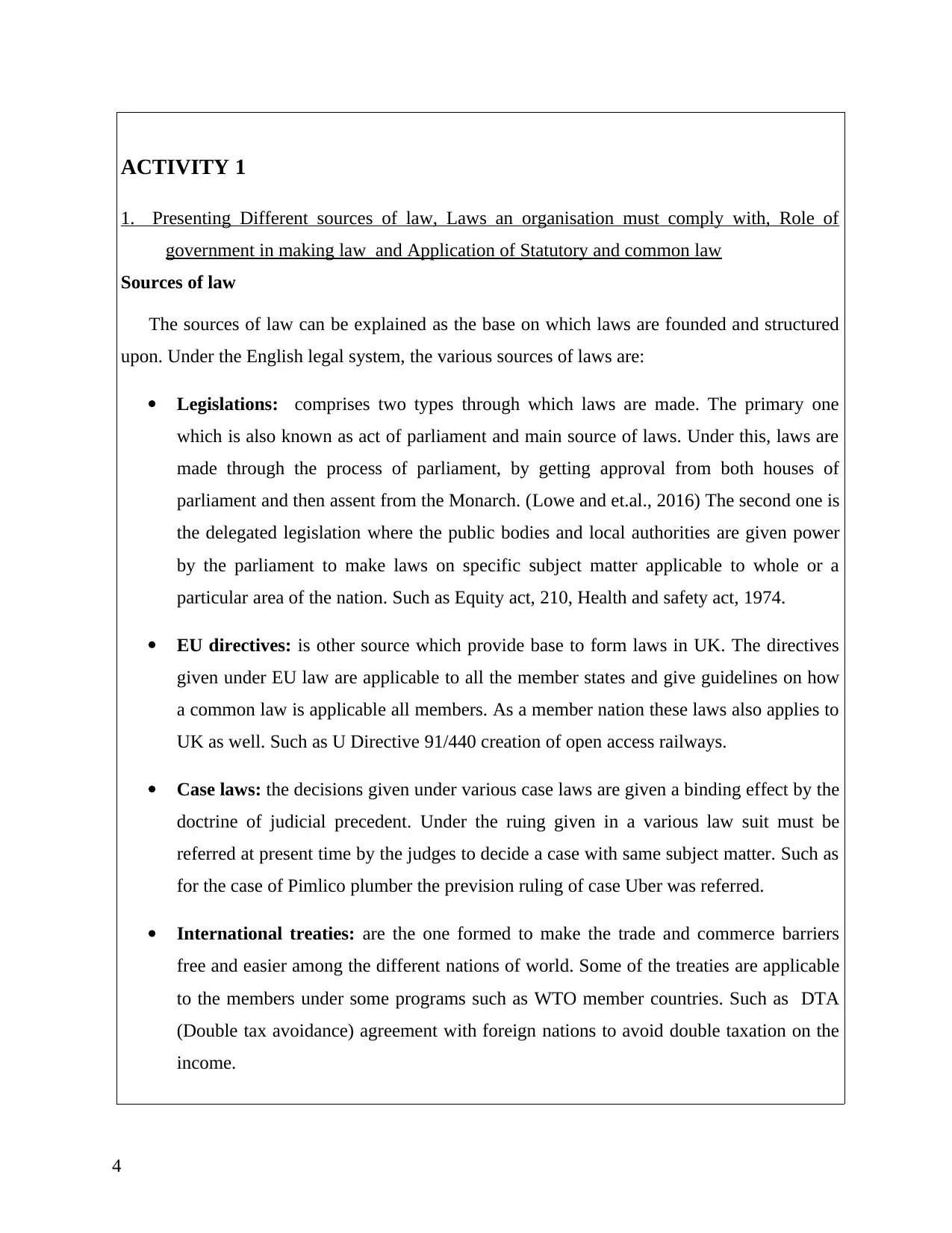
ACTIVITY 1
1. Presenting Different sources of law, Laws an organisation must comply with, Role of
government in making law and Application of Statutory and common law
Sources of law
The sources of law can be explained as the base on which laws are founded and structured
upon. Under the English legal system, the various sources of laws are:
Legislations: comprises two types through which laws are made. The primary one
which is also known as act of parliament and main source of laws. Under this, laws are
made through the process of parliament, by getting approval from both houses of
parliament and then assent from the Monarch. (Lowe and et.al., 2016) The second one is
the delegated legislation where the public bodies and local authorities are given power
by the parliament to make laws on specific subject matter applicable to whole or a
particular area of the nation. Such as Equity act, 210, Health and safety act, 1974.
EU directives: is other source which provide base to form laws in UK. The directives
given under EU law are applicable to all the member states and give guidelines on how
a common law is applicable all members. As a member nation these laws also applies to
UK as well. Such as U Directive 91/440 creation of open access railways.
Case laws: the decisions given under various case laws are given a binding effect by the
doctrine of judicial precedent. Under the ruing given in a various law suit must be
referred at present time by the judges to decide a case with same subject matter. Such as
for the case of Pimlico plumber the prevision ruling of case Uber was referred.
International treaties: are the one formed to make the trade and commerce barriers
free and easier among the different nations of world. Some of the treaties are applicable
to the members under some programs such as WTO member countries. Such as DTA
(Double tax avoidance) agreement with foreign nations to avoid double taxation on the
income.
4
1. Presenting Different sources of law, Laws an organisation must comply with, Role of
government in making law and Application of Statutory and common law
Sources of law
The sources of law can be explained as the base on which laws are founded and structured
upon. Under the English legal system, the various sources of laws are:
Legislations: comprises two types through which laws are made. The primary one
which is also known as act of parliament and main source of laws. Under this, laws are
made through the process of parliament, by getting approval from both houses of
parliament and then assent from the Monarch. (Lowe and et.al., 2016) The second one is
the delegated legislation where the public bodies and local authorities are given power
by the parliament to make laws on specific subject matter applicable to whole or a
particular area of the nation. Such as Equity act, 210, Health and safety act, 1974.
EU directives: is other source which provide base to form laws in UK. The directives
given under EU law are applicable to all the member states and give guidelines on how
a common law is applicable all members. As a member nation these laws also applies to
UK as well. Such as U Directive 91/440 creation of open access railways.
Case laws: the decisions given under various case laws are given a binding effect by the
doctrine of judicial precedent. Under the ruing given in a various law suit must be
referred at present time by the judges to decide a case with same subject matter. Such as
for the case of Pimlico plumber the prevision ruling of case Uber was referred.
International treaties: are the one formed to make the trade and commerce barriers
free and easier among the different nations of world. Some of the treaties are applicable
to the members under some programs such as WTO member countries. Such as DTA
(Double tax avoidance) agreement with foreign nations to avoid double taxation on the
income.
4
Paraphrase This Document
Need a fresh take? Get an instant paraphrase of this document with our AI Paraphraser
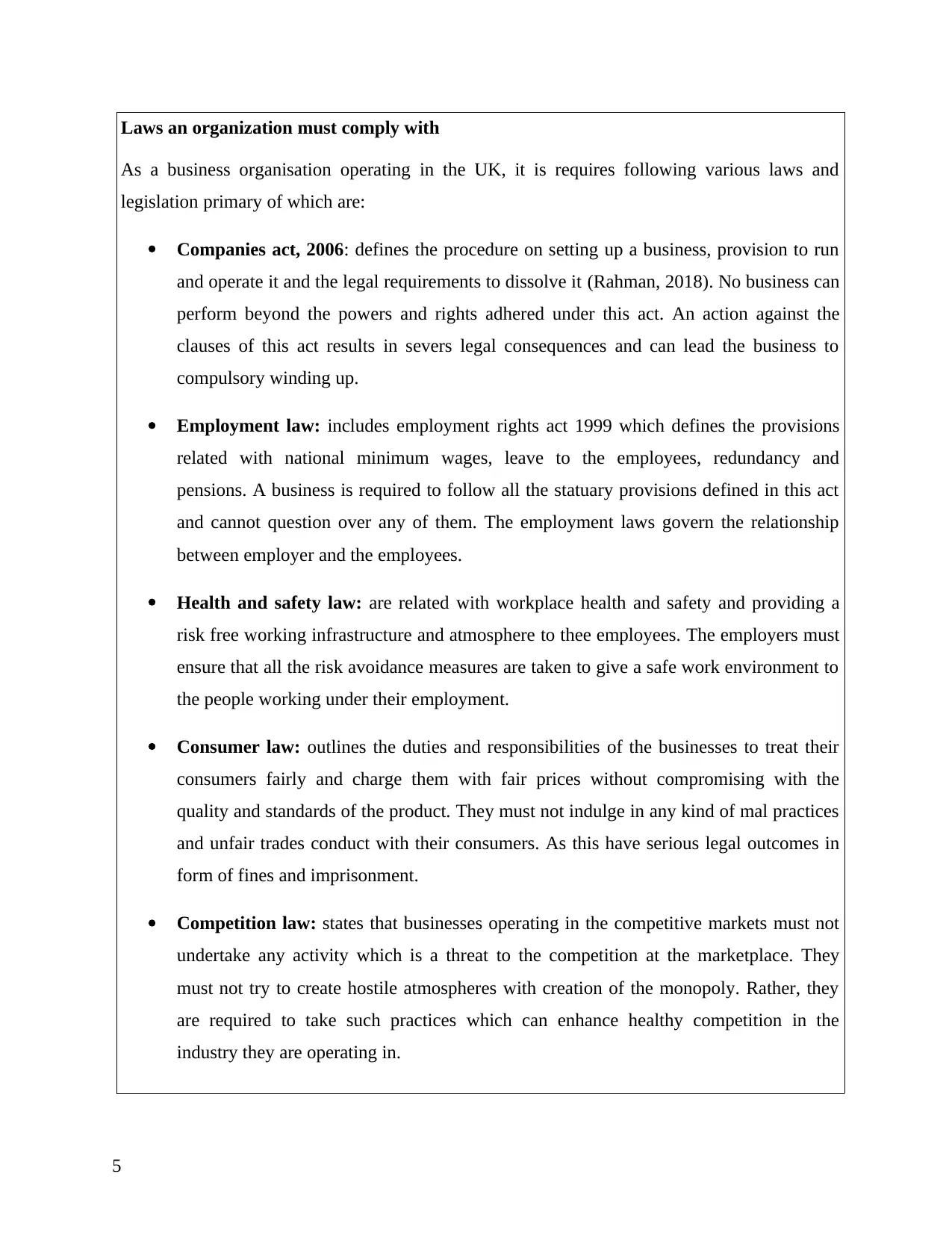
Laws an organization must comply with
As a business organisation operating in the UK, it is requires following various laws and
legislation primary of which are:
Companies act, 2006: defines the procedure on setting up a business, provision to run
and operate it and the legal requirements to dissolve it (Rahman, 2018). No business can
perform beyond the powers and rights adhered under this act. An action against the
clauses of this act results in severs legal consequences and can lead the business to
compulsory winding up.
Employment law: includes employment rights act 1999 which defines the provisions
related with national minimum wages, leave to the employees, redundancy and
pensions. A business is required to follow all the statuary provisions defined in this act
and cannot question over any of them. The employment laws govern the relationship
between employer and the employees.
Health and safety law: are related with workplace health and safety and providing a
risk free working infrastructure and atmosphere to thee employees. The employers must
ensure that all the risk avoidance measures are taken to give a safe work environment to
the people working under their employment.
Consumer law: outlines the duties and responsibilities of the businesses to treat their
consumers fairly and charge them with fair prices without compromising with the
quality and standards of the product. They must not indulge in any kind of mal practices
and unfair trades conduct with their consumers. As this have serious legal outcomes in
form of fines and imprisonment.
Competition law: states that businesses operating in the competitive markets must not
undertake any activity which is a threat to the competition at the marketplace. They
must not try to create hostile atmospheres with creation of the monopoly. Rather, they
are required to take such practices which can enhance healthy competition in the
industry they are operating in.
5
As a business organisation operating in the UK, it is requires following various laws and
legislation primary of which are:
Companies act, 2006: defines the procedure on setting up a business, provision to run
and operate it and the legal requirements to dissolve it (Rahman, 2018). No business can
perform beyond the powers and rights adhered under this act. An action against the
clauses of this act results in severs legal consequences and can lead the business to
compulsory winding up.
Employment law: includes employment rights act 1999 which defines the provisions
related with national minimum wages, leave to the employees, redundancy and
pensions. A business is required to follow all the statuary provisions defined in this act
and cannot question over any of them. The employment laws govern the relationship
between employer and the employees.
Health and safety law: are related with workplace health and safety and providing a
risk free working infrastructure and atmosphere to thee employees. The employers must
ensure that all the risk avoidance measures are taken to give a safe work environment to
the people working under their employment.
Consumer law: outlines the duties and responsibilities of the businesses to treat their
consumers fairly and charge them with fair prices without compromising with the
quality and standards of the product. They must not indulge in any kind of mal practices
and unfair trades conduct with their consumers. As this have serious legal outcomes in
form of fines and imprisonment.
Competition law: states that businesses operating in the competitive markets must not
undertake any activity which is a threat to the competition at the marketplace. They
must not try to create hostile atmospheres with creation of the monopoly. Rather, they
are required to take such practices which can enhance healthy competition in the
industry they are operating in.
5
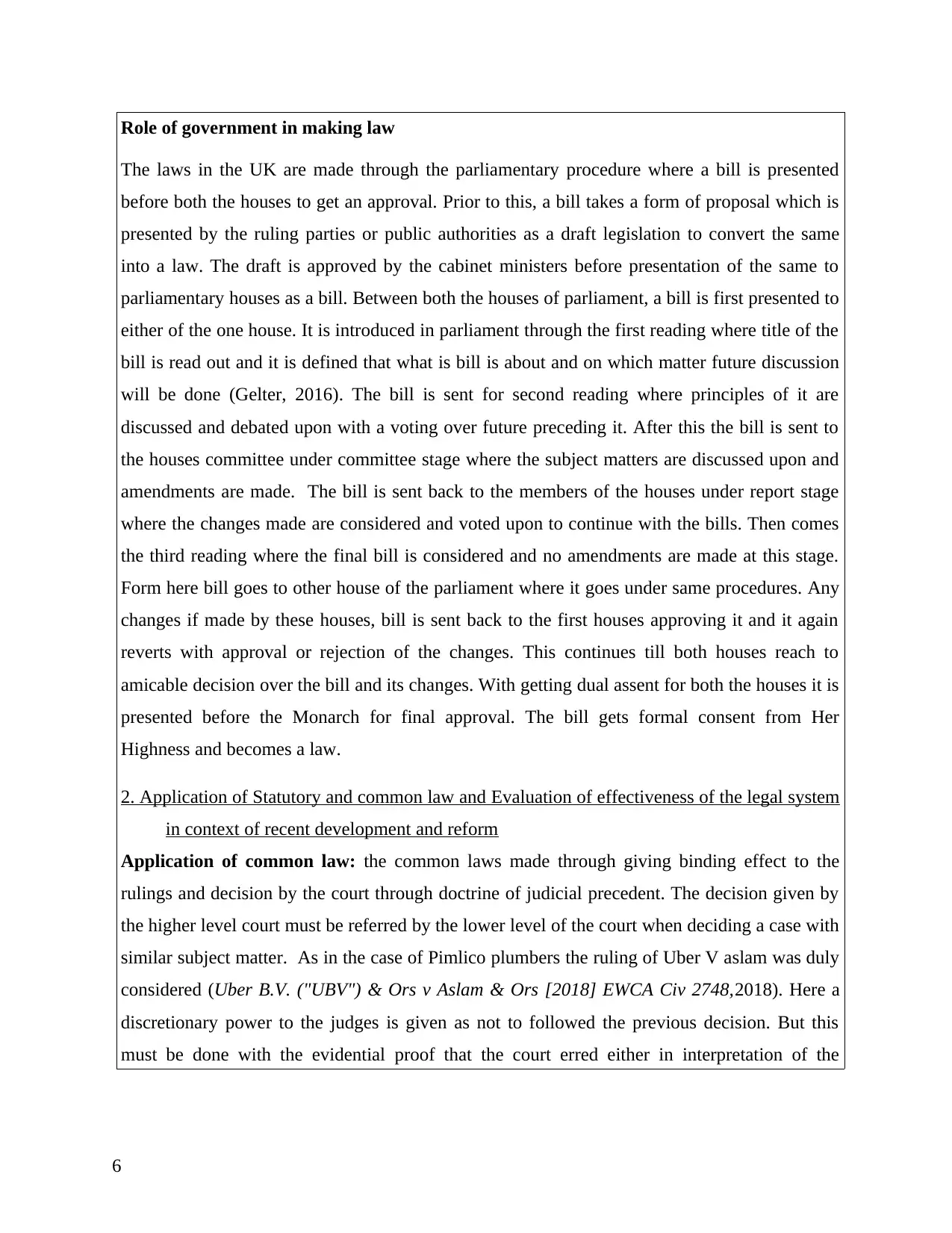
Role of government in making law
The laws in the UK are made through the parliamentary procedure where a bill is presented
before both the houses to get an approval. Prior to this, a bill takes a form of proposal which is
presented by the ruling parties or public authorities as a draft legislation to convert the same
into a law. The draft is approved by the cabinet ministers before presentation of the same to
parliamentary houses as a bill. Between both the houses of parliament, a bill is first presented to
either of the one house. It is introduced in parliament through the first reading where title of the
bill is read out and it is defined that what is bill is about and on which matter future discussion
will be done (Gelter, 2016). The bill is sent for second reading where principles of it are
discussed and debated upon with a voting over future preceding it. After this the bill is sent to
the houses committee under committee stage where the subject matters are discussed upon and
amendments are made. The bill is sent back to the members of the houses under report stage
where the changes made are considered and voted upon to continue with the bills. Then comes
the third reading where the final bill is considered and no amendments are made at this stage.
Form here bill goes to other house of the parliament where it goes under same procedures. Any
changes if made by these houses, bill is sent back to the first houses approving it and it again
reverts with approval or rejection of the changes. This continues till both houses reach to
amicable decision over the bill and its changes. With getting dual assent for both the houses it is
presented before the Monarch for final approval. The bill gets formal consent from Her
Highness and becomes a law.
2. Application of Statutory and common law and Evaluation of effectiveness of the legal system
in context of recent development and reform
Application of common law: the common laws made through giving binding effect to the
rulings and decision by the court through doctrine of judicial precedent. The decision given by
the higher level court must be referred by the lower level of the court when deciding a case with
similar subject matter. As in the case of Pimlico plumbers the ruling of Uber V aslam was duly
considered (Uber B.V. ("UBV") & Ors v Aslam & Ors [2018] EWCA Civ 2748,2018). Here a
discretionary power to the judges is given as not to followed the previous decision. But this
must be done with the evidential proof that the court erred either in interpretation of the
6
The laws in the UK are made through the parliamentary procedure where a bill is presented
before both the houses to get an approval. Prior to this, a bill takes a form of proposal which is
presented by the ruling parties or public authorities as a draft legislation to convert the same
into a law. The draft is approved by the cabinet ministers before presentation of the same to
parliamentary houses as a bill. Between both the houses of parliament, a bill is first presented to
either of the one house. It is introduced in parliament through the first reading where title of the
bill is read out and it is defined that what is bill is about and on which matter future discussion
will be done (Gelter, 2016). The bill is sent for second reading where principles of it are
discussed and debated upon with a voting over future preceding it. After this the bill is sent to
the houses committee under committee stage where the subject matters are discussed upon and
amendments are made. The bill is sent back to the members of the houses under report stage
where the changes made are considered and voted upon to continue with the bills. Then comes
the third reading where the final bill is considered and no amendments are made at this stage.
Form here bill goes to other house of the parliament where it goes under same procedures. Any
changes if made by these houses, bill is sent back to the first houses approving it and it again
reverts with approval or rejection of the changes. This continues till both houses reach to
amicable decision over the bill and its changes. With getting dual assent for both the houses it is
presented before the Monarch for final approval. The bill gets formal consent from Her
Highness and becomes a law.
2. Application of Statutory and common law and Evaluation of effectiveness of the legal system
in context of recent development and reform
Application of common law: the common laws made through giving binding effect to the
rulings and decision by the court through doctrine of judicial precedent. The decision given by
the higher level court must be referred by the lower level of the court when deciding a case with
similar subject matter. As in the case of Pimlico plumbers the ruling of Uber V aslam was duly
considered (Uber B.V. ("UBV") & Ors v Aslam & Ors [2018] EWCA Civ 2748,2018). Here a
discretionary power to the judges is given as not to followed the previous decision. But this
must be done with the evidential proof that the court erred either in interpretation of the
6
⊘ This is a preview!⊘
Do you want full access?
Subscribe today to unlock all pages.

Trusted by 1+ million students worldwide
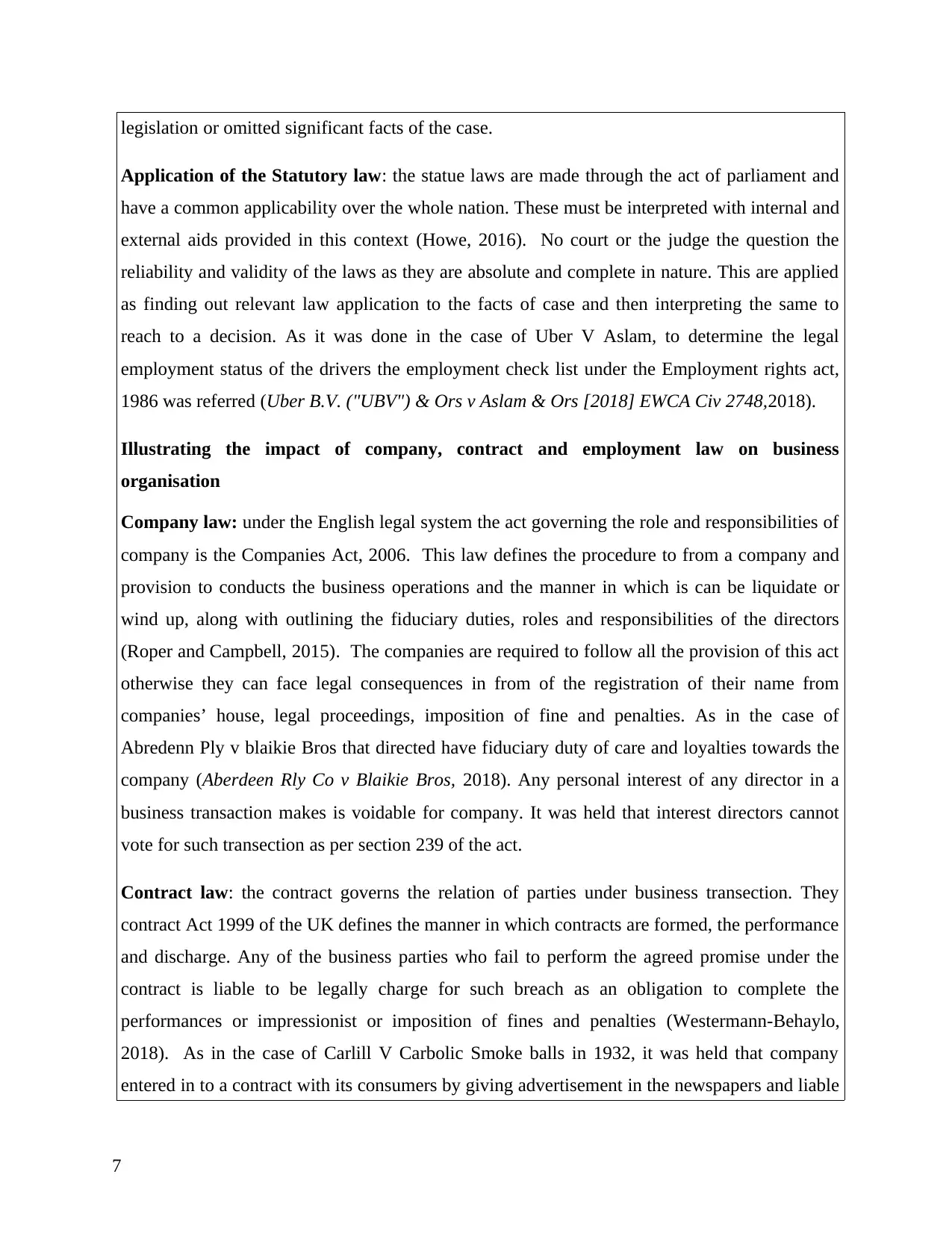
legislation or omitted significant facts of the case.
Application of the Statutory law: the statue laws are made through the act of parliament and
have a common applicability over the whole nation. These must be interpreted with internal and
external aids provided in this context (Howe, 2016). No court or the judge the question the
reliability and validity of the laws as they are absolute and complete in nature. This are applied
as finding out relevant law application to the facts of case and then interpreting the same to
reach to a decision. As it was done in the case of Uber V Aslam, to determine the legal
employment status of the drivers the employment check list under the Employment rights act,
1986 was referred (Uber B.V. ("UBV") & Ors v Aslam & Ors [2018] EWCA Civ 2748,2018).
Illustrating the impact of company, contract and employment law on business
organisation
Company law: under the English legal system the act governing the role and responsibilities of
company is the Companies Act, 2006. This law defines the procedure to from a company and
provision to conducts the business operations and the manner in which is can be liquidate or
wind up, along with outlining the fiduciary duties, roles and responsibilities of the directors
(Roper and Campbell, 2015). The companies are required to follow all the provision of this act
otherwise they can face legal consequences in from of the registration of their name from
companies’ house, legal proceedings, imposition of fine and penalties. As in the case of
Abredenn Ply v blaikie Bros that directed have fiduciary duty of care and loyalties towards the
company (Aberdeen Rly Co v Blaikie Bros, 2018). Any personal interest of any director in a
business transaction makes is voidable for company. It was held that interest directors cannot
vote for such transection as per section 239 of the act.
Contract law: the contract governs the relation of parties under business transection. They
contract Act 1999 of the UK defines the manner in which contracts are formed, the performance
and discharge. Any of the business parties who fail to perform the agreed promise under the
contract is liable to be legally charge for such breach as an obligation to complete the
performances or impressionist or imposition of fines and penalties (Westermann-Behaylo,
2018). As in the case of Carlill V Carbolic Smoke balls in 1932, it was held that company
entered in to a contract with its consumers by giving advertisement in the newspapers and liable
7
Application of the Statutory law: the statue laws are made through the act of parliament and
have a common applicability over the whole nation. These must be interpreted with internal and
external aids provided in this context (Howe, 2016). No court or the judge the question the
reliability and validity of the laws as they are absolute and complete in nature. This are applied
as finding out relevant law application to the facts of case and then interpreting the same to
reach to a decision. As it was done in the case of Uber V Aslam, to determine the legal
employment status of the drivers the employment check list under the Employment rights act,
1986 was referred (Uber B.V. ("UBV") & Ors v Aslam & Ors [2018] EWCA Civ 2748,2018).
Illustrating the impact of company, contract and employment law on business
organisation
Company law: under the English legal system the act governing the role and responsibilities of
company is the Companies Act, 2006. This law defines the procedure to from a company and
provision to conducts the business operations and the manner in which is can be liquidate or
wind up, along with outlining the fiduciary duties, roles and responsibilities of the directors
(Roper and Campbell, 2015). The companies are required to follow all the provision of this act
otherwise they can face legal consequences in from of the registration of their name from
companies’ house, legal proceedings, imposition of fine and penalties. As in the case of
Abredenn Ply v blaikie Bros that directed have fiduciary duty of care and loyalties towards the
company (Aberdeen Rly Co v Blaikie Bros, 2018). Any personal interest of any director in a
business transaction makes is voidable for company. It was held that interest directors cannot
vote for such transection as per section 239 of the act.
Contract law: the contract governs the relation of parties under business transection. They
contract Act 1999 of the UK defines the manner in which contracts are formed, the performance
and discharge. Any of the business parties who fail to perform the agreed promise under the
contract is liable to be legally charge for such breach as an obligation to complete the
performances or impressionist or imposition of fines and penalties (Westermann-Behaylo,
2018). As in the case of Carlill V Carbolic Smoke balls in 1932, it was held that company
entered in to a contract with its consumers by giving advertisement in the newspapers and liable
7
Paraphrase This Document
Need a fresh take? Get an instant paraphrase of this document with our AI Paraphraser
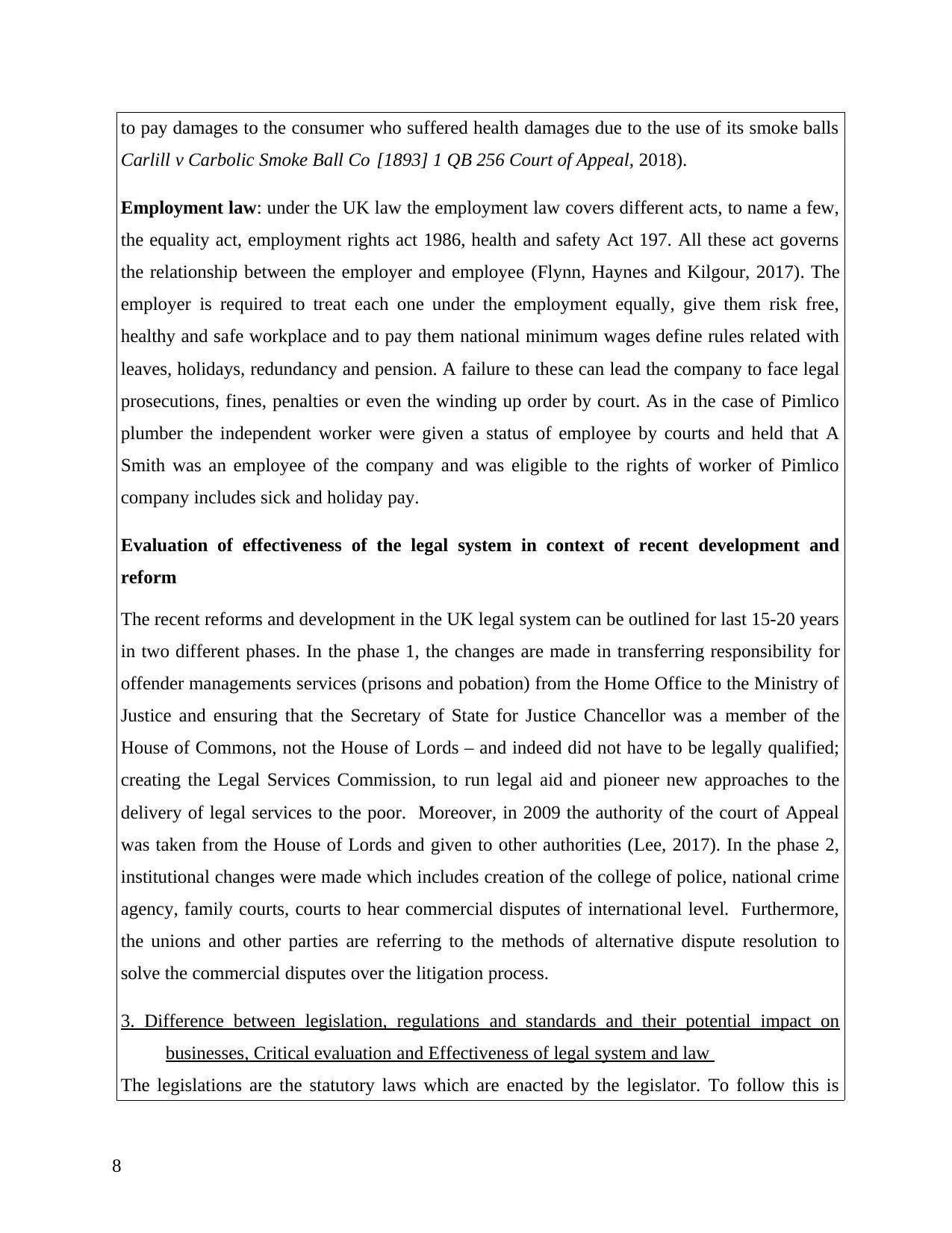
to pay damages to the consumer who suffered health damages due to the use of its smoke balls
Carlill v Carbolic Smoke Ball Co [1893] 1 QB 256 Court of Appeal, 2018).
Employment law: under the UK law the employment law covers different acts, to name a few,
the equality act, employment rights act 1986, health and safety Act 197. All these act governs
the relationship between the employer and employee (Flynn, Haynes and Kilgour, 2017). The
employer is required to treat each one under the employment equally, give them risk free,
healthy and safe workplace and to pay them national minimum wages define rules related with
leaves, holidays, redundancy and pension. A failure to these can lead the company to face legal
prosecutions, fines, penalties or even the winding up order by court. As in the case of Pimlico
plumber the independent worker were given a status of employee by courts and held that A
Smith was an employee of the company and was eligible to the rights of worker of Pimlico
company includes sick and holiday pay.
Evaluation of effectiveness of the legal system in context of recent development and
reform
The recent reforms and development in the UK legal system can be outlined for last 15-20 years
in two different phases. In the phase 1, the changes are made in transferring responsibility for
offender managements services (prisons and pobation) from the Home Office to the Ministry of
Justice and ensuring that the Secretary of State for Justice Chancellor was a member of the
House of Commons, not the House of Lords – and indeed did not have to be legally qualified;
creating the Legal Services Commission, to run legal aid and pioneer new approaches to the
delivery of legal services to the poor. Moreover, in 2009 the authority of the court of Appeal
was taken from the House of Lords and given to other authorities (Lee, 2017). In the phase 2,
institutional changes were made which includes creation of the college of police, national crime
agency, family courts, courts to hear commercial disputes of international level. Furthermore,
the unions and other parties are referring to the methods of alternative dispute resolution to
solve the commercial disputes over the litigation process.
3. Difference between legislation, regulations and standards and their potential impact on
businesses, Critical evaluation and Effectiveness of legal system and law
The legislations are the statutory laws which are enacted by the legislator. To follow this is
8
Carlill v Carbolic Smoke Ball Co [1893] 1 QB 256 Court of Appeal, 2018).
Employment law: under the UK law the employment law covers different acts, to name a few,
the equality act, employment rights act 1986, health and safety Act 197. All these act governs
the relationship between the employer and employee (Flynn, Haynes and Kilgour, 2017). The
employer is required to treat each one under the employment equally, give them risk free,
healthy and safe workplace and to pay them national minimum wages define rules related with
leaves, holidays, redundancy and pension. A failure to these can lead the company to face legal
prosecutions, fines, penalties or even the winding up order by court. As in the case of Pimlico
plumber the independent worker were given a status of employee by courts and held that A
Smith was an employee of the company and was eligible to the rights of worker of Pimlico
company includes sick and holiday pay.
Evaluation of effectiveness of the legal system in context of recent development and
reform
The recent reforms and development in the UK legal system can be outlined for last 15-20 years
in two different phases. In the phase 1, the changes are made in transferring responsibility for
offender managements services (prisons and pobation) from the Home Office to the Ministry of
Justice and ensuring that the Secretary of State for Justice Chancellor was a member of the
House of Commons, not the House of Lords – and indeed did not have to be legally qualified;
creating the Legal Services Commission, to run legal aid and pioneer new approaches to the
delivery of legal services to the poor. Moreover, in 2009 the authority of the court of Appeal
was taken from the House of Lords and given to other authorities (Lee, 2017). In the phase 2,
institutional changes were made which includes creation of the college of police, national crime
agency, family courts, courts to hear commercial disputes of international level. Furthermore,
the unions and other parties are referring to the methods of alternative dispute resolution to
solve the commercial disputes over the litigation process.
3. Difference between legislation, regulations and standards and their potential impact on
businesses, Critical evaluation and Effectiveness of legal system and law
The legislations are the statutory laws which are enacted by the legislator. To follow this is
8

compulsory and no one can deny doing so. The regulations on the other hand are the extension
of the laws and gives the general principles for application of the legislation. Such as the
company law requires collection of fees for the registration of a company. It defines the values,
amount, manner of the fees and it collection. The company regulation in this regard indicate
how, when and where will the fees be collected. The legislations and regulations are required
to be abide with compulsory without no lag as this can lead the business in facing legal charges
and prosecution, fines, imprisonments or even striking out the name of company from
companies house. Conversely, the standards are the specific guild lines for a product, services
and system. The conformity with standards is voluntary such as the Health and safety standards
defines the specific guidelines over the work environment apart from basis regulation which an
organisation may or may not follow
Critical evaluation of legal system and law with presenting evidences in form of examples
The evaluation of all three above mentioned terms can be done as the legislations such as
Employment Act 2015 is required to be followed by a business compulsorily whereas the
Employment regulation 1999 are explanation to the act so it is also required to be achieved
compulsorily (Oliver and Rutterford, 2019). Whereas the health and safety standards 2010 are
the definite bar to maintain and health and safety under occupation and this is not the choice of
the business to follow it or not. For this it can be stated that the regulations and regulation is the
responsibility of the company to follow while the standard are voluntary to be follow or not as
per the discretionary power of the business organisation.
Effectiveness of legal system and laws
The effectiveness of the legal system can be stated as that with recent reforms and development
the court justice structure have been made more definite with ruling out any outside
involvement in the legal structure (Olsen, 2015). The power of passing decision is given to the
all the courts and all parliamentary interferences are ruled out. Moreover, the constitution of the
UK is not present in a single codifies from that all written laws are present in one documents.
But still all the laws are presented in written forms and its strict applicability makes the legal
system coherent and cohesive.
4. Appropriate legal solutions to range of business problems and their evaluation and
9
of the laws and gives the general principles for application of the legislation. Such as the
company law requires collection of fees for the registration of a company. It defines the values,
amount, manner of the fees and it collection. The company regulation in this regard indicate
how, when and where will the fees be collected. The legislations and regulations are required
to be abide with compulsory without no lag as this can lead the business in facing legal charges
and prosecution, fines, imprisonments or even striking out the name of company from
companies house. Conversely, the standards are the specific guild lines for a product, services
and system. The conformity with standards is voluntary such as the Health and safety standards
defines the specific guidelines over the work environment apart from basis regulation which an
organisation may or may not follow
Critical evaluation of legal system and law with presenting evidences in form of examples
The evaluation of all three above mentioned terms can be done as the legislations such as
Employment Act 2015 is required to be followed by a business compulsorily whereas the
Employment regulation 1999 are explanation to the act so it is also required to be achieved
compulsorily (Oliver and Rutterford, 2019). Whereas the health and safety standards 2010 are
the definite bar to maintain and health and safety under occupation and this is not the choice of
the business to follow it or not. For this it can be stated that the regulations and regulation is the
responsibility of the company to follow while the standard are voluntary to be follow or not as
per the discretionary power of the business organisation.
Effectiveness of legal system and laws
The effectiveness of the legal system can be stated as that with recent reforms and development
the court justice structure have been made more definite with ruling out any outside
involvement in the legal structure (Olsen, 2015). The power of passing decision is given to the
all the courts and all parliamentary interferences are ruled out. Moreover, the constitution of the
UK is not present in a single codifies from that all written laws are present in one documents.
But still all the laws are presented in written forms and its strict applicability makes the legal
system coherent and cohesive.
4. Appropriate legal solutions to range of business problems and their evaluation and
9
⊘ This is a preview!⊘
Do you want full access?
Subscribe today to unlock all pages.

Trusted by 1+ million students worldwide
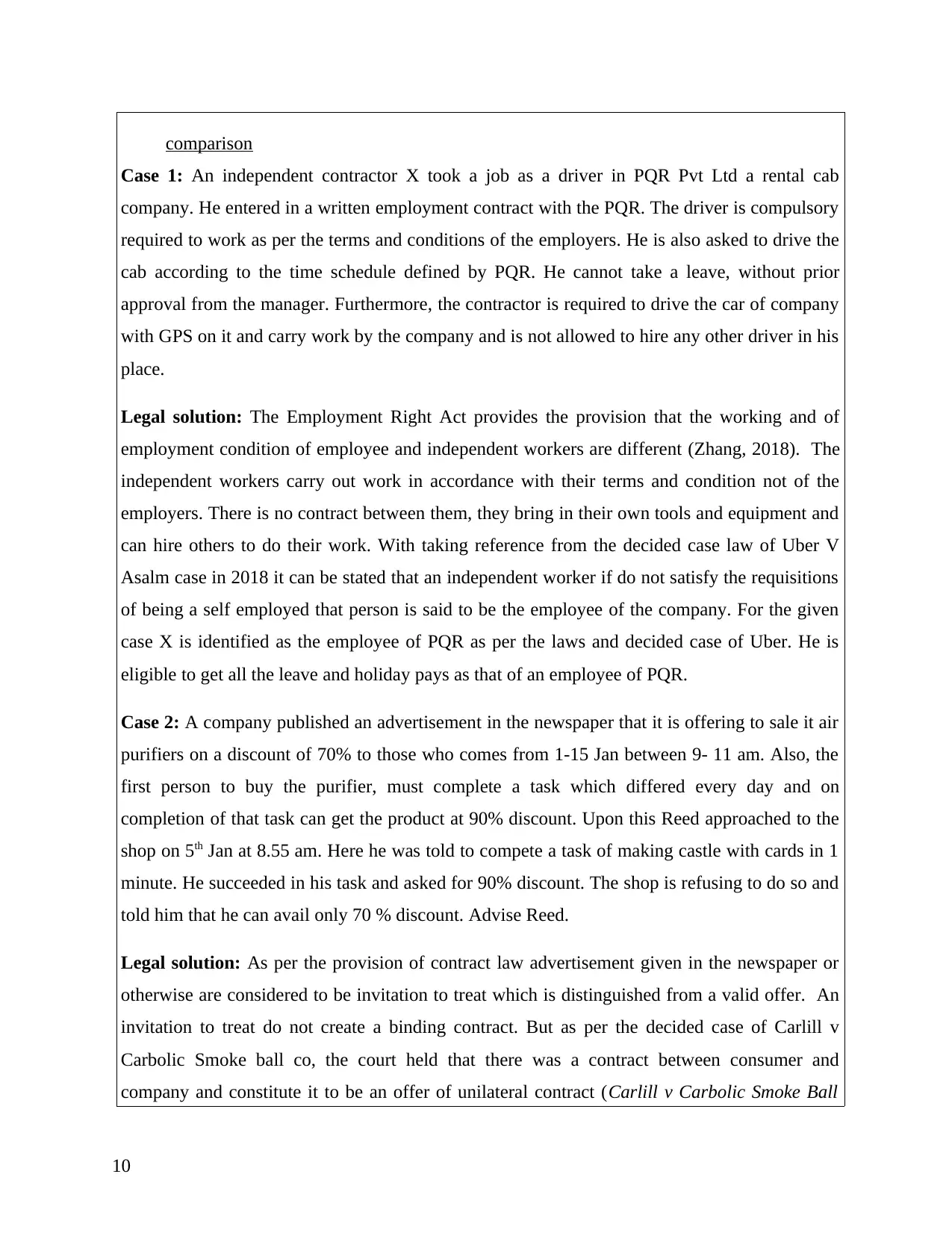
comparison
Case 1: An independent contractor X took a job as a driver in PQR Pvt Ltd a rental cab
company. He entered in a written employment contract with the PQR. The driver is compulsory
required to work as per the terms and conditions of the employers. He is also asked to drive the
cab according to the time schedule defined by PQR. He cannot take a leave, without prior
approval from the manager. Furthermore, the contractor is required to drive the car of company
with GPS on it and carry work by the company and is not allowed to hire any other driver in his
place.
Legal solution: The Employment Right Act provides the provision that the working and of
employment condition of employee and independent workers are different (Zhang, 2018). The
independent workers carry out work in accordance with their terms and condition not of the
employers. There is no contract between them, they bring in their own tools and equipment and
can hire others to do their work. With taking reference from the decided case law of Uber V
Asalm case in 2018 it can be stated that an independent worker if do not satisfy the requisitions
of being a self employed that person is said to be the employee of the company. For the given
case X is identified as the employee of PQR as per the laws and decided case of Uber. He is
eligible to get all the leave and holiday pays as that of an employee of PQR.
Case 2: A company published an advertisement in the newspaper that it is offering to sale it air
purifiers on a discount of 70% to those who comes from 1-15 Jan between 9- 11 am. Also, the
first person to buy the purifier, must complete a task which differed every day and on
completion of that task can get the product at 90% discount. Upon this Reed approached to the
shop on 5th Jan at 8.55 am. Here he was told to compete a task of making castle with cards in 1
minute. He succeeded in his task and asked for 90% discount. The shop is refusing to do so and
told him that he can avail only 70 % discount. Advise Reed.
Legal solution: As per the provision of contract law advertisement given in the newspaper or
otherwise are considered to be invitation to treat which is distinguished from a valid offer. An
invitation to treat do not create a binding contract. But as per the decided case of Carlill v
Carbolic Smoke ball co, the court held that there was a contract between consumer and
company and constitute it to be an offer of unilateral contract (Carlill v Carbolic Smoke Ball
10
Case 1: An independent contractor X took a job as a driver in PQR Pvt Ltd a rental cab
company. He entered in a written employment contract with the PQR. The driver is compulsory
required to work as per the terms and conditions of the employers. He is also asked to drive the
cab according to the time schedule defined by PQR. He cannot take a leave, without prior
approval from the manager. Furthermore, the contractor is required to drive the car of company
with GPS on it and carry work by the company and is not allowed to hire any other driver in his
place.
Legal solution: The Employment Right Act provides the provision that the working and of
employment condition of employee and independent workers are different (Zhang, 2018). The
independent workers carry out work in accordance with their terms and condition not of the
employers. There is no contract between them, they bring in their own tools and equipment and
can hire others to do their work. With taking reference from the decided case law of Uber V
Asalm case in 2018 it can be stated that an independent worker if do not satisfy the requisitions
of being a self employed that person is said to be the employee of the company. For the given
case X is identified as the employee of PQR as per the laws and decided case of Uber. He is
eligible to get all the leave and holiday pays as that of an employee of PQR.
Case 2: A company published an advertisement in the newspaper that it is offering to sale it air
purifiers on a discount of 70% to those who comes from 1-15 Jan between 9- 11 am. Also, the
first person to buy the purifier, must complete a task which differed every day and on
completion of that task can get the product at 90% discount. Upon this Reed approached to the
shop on 5th Jan at 8.55 am. Here he was told to compete a task of making castle with cards in 1
minute. He succeeded in his task and asked for 90% discount. The shop is refusing to do so and
told him that he can avail only 70 % discount. Advise Reed.
Legal solution: As per the provision of contract law advertisement given in the newspaper or
otherwise are considered to be invitation to treat which is distinguished from a valid offer. An
invitation to treat do not create a binding contract. But as per the decided case of Carlill v
Carbolic Smoke ball co, the court held that there was a contract between consumer and
company and constitute it to be an offer of unilateral contract (Carlill v Carbolic Smoke Ball
10
Paraphrase This Document
Need a fresh take? Get an instant paraphrase of this document with our AI Paraphraser
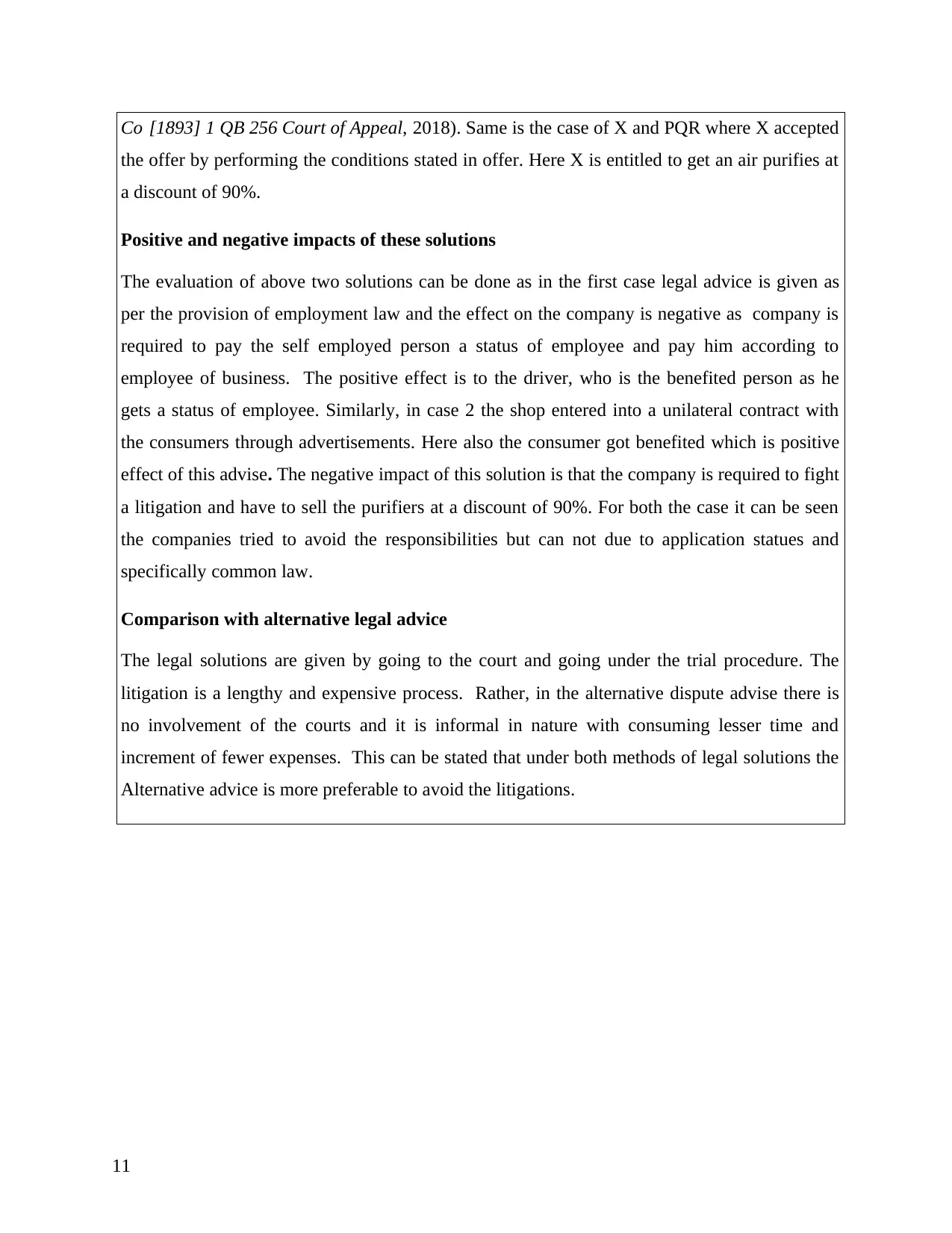
Co [1893] 1 QB 256 Court of Appeal, 2018). Same is the case of X and PQR where X accepted
the offer by performing the conditions stated in offer. Here X is entitled to get an air purifies at
a discount of 90%.
Positive and negative impacts of these solutions
The evaluation of above two solutions can be done as in the first case legal advice is given as
per the provision of employment law and the effect on the company is negative as company is
required to pay the self employed person a status of employee and pay him according to
employee of business. The positive effect is to the driver, who is the benefited person as he
gets a status of employee. Similarly, in case 2 the shop entered into a unilateral contract with
the consumers through advertisements. Here also the consumer got benefited which is positive
effect of this advise. The negative impact of this solution is that the company is required to fight
a litigation and have to sell the purifiers at a discount of 90%. For both the case it can be seen
the companies tried to avoid the responsibilities but can not due to application statues and
specifically common law.
Comparison with alternative legal advice
The legal solutions are given by going to the court and going under the trial procedure. The
litigation is a lengthy and expensive process. Rather, in the alternative dispute advise there is
no involvement of the courts and it is informal in nature with consuming lesser time and
increment of fewer expenses. This can be stated that under both methods of legal solutions the
Alternative advice is more preferable to avoid the litigations.
11
the offer by performing the conditions stated in offer. Here X is entitled to get an air purifies at
a discount of 90%.
Positive and negative impacts of these solutions
The evaluation of above two solutions can be done as in the first case legal advice is given as
per the provision of employment law and the effect on the company is negative as company is
required to pay the self employed person a status of employee and pay him according to
employee of business. The positive effect is to the driver, who is the benefited person as he
gets a status of employee. Similarly, in case 2 the shop entered into a unilateral contract with
the consumers through advertisements. Here also the consumer got benefited which is positive
effect of this advise. The negative impact of this solution is that the company is required to fight
a litigation and have to sell the purifiers at a discount of 90%. For both the case it can be seen
the companies tried to avoid the responsibilities but can not due to application statues and
specifically common law.
Comparison with alternative legal advice
The legal solutions are given by going to the court and going under the trial procedure. The
litigation is a lengthy and expensive process. Rather, in the alternative dispute advise there is
no involvement of the courts and it is informal in nature with consuming lesser time and
increment of fewer expenses. This can be stated that under both methods of legal solutions the
Alternative advice is more preferable to avoid the litigations.
11
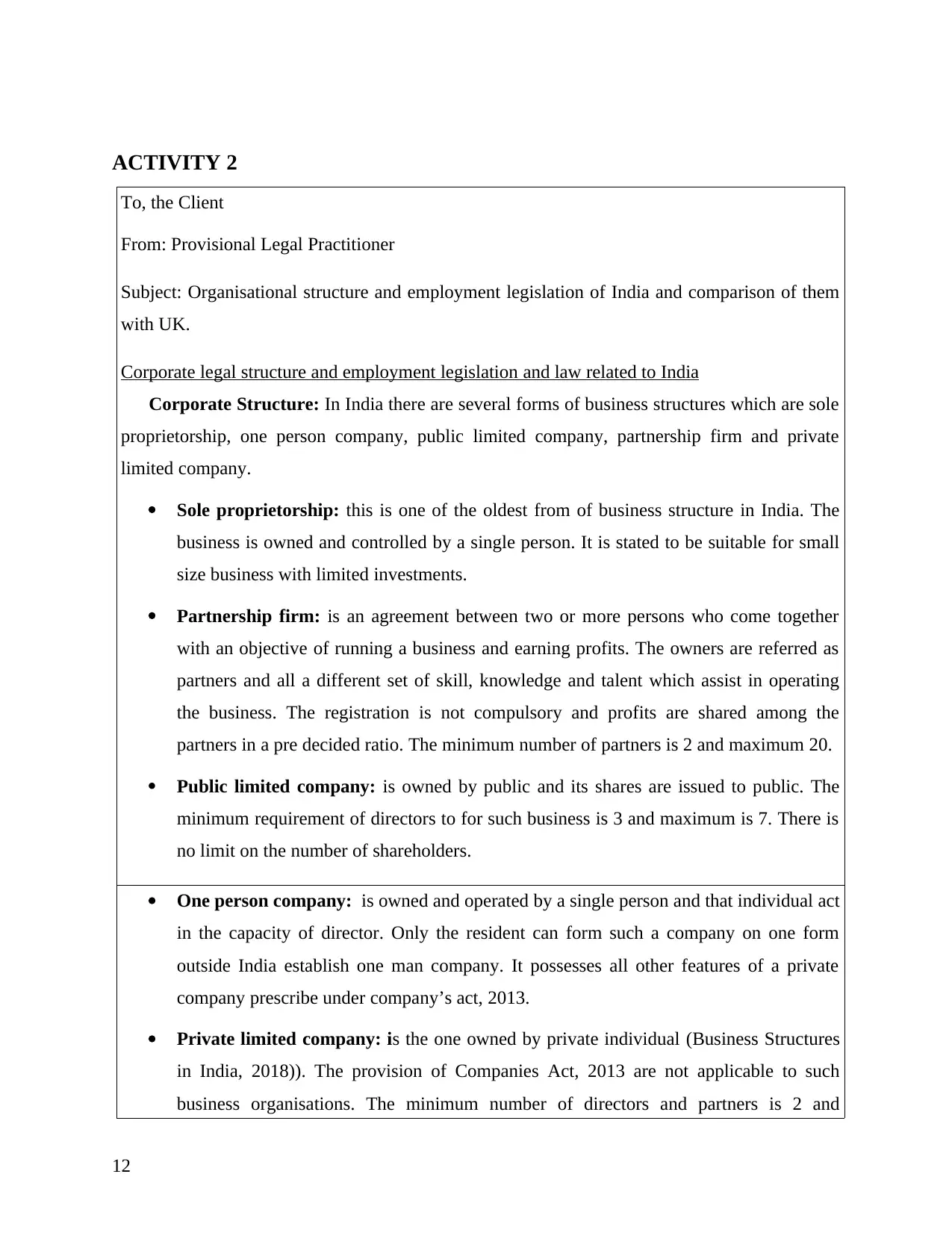
ACTIVITY 2
To, the Client
From: Provisional Legal Practitioner
Subject: Organisational structure and employment legislation of India and comparison of them
with UK.
Corporate legal structure and employment legislation and law related to India
Corporate Structure: In India there are several forms of business structures which are sole
proprietorship, one person company, public limited company, partnership firm and private
limited company.
Sole proprietorship: this is one of the oldest from of business structure in India. The
business is owned and controlled by a single person. It is stated to be suitable for small
size business with limited investments.
Partnership firm: is an agreement between two or more persons who come together
with an objective of running a business and earning profits. The owners are referred as
partners and all a different set of skill, knowledge and talent which assist in operating
the business. The registration is not compulsory and profits are shared among the
partners in a pre decided ratio. The minimum number of partners is 2 and maximum 20.
Public limited company: is owned by public and its shares are issued to public. The
minimum requirement of directors to for such business is 3 and maximum is 7. There is
no limit on the number of shareholders.
One person company: is owned and operated by a single person and that individual act
in the capacity of director. Only the resident can form such a company on one form
outside India establish one man company. It possesses all other features of a private
company prescribe under company’s act, 2013.
Private limited company: is the one owned by private individual (Business Structures
in India, 2018)). The provision of Companies Act, 2013 are not applicable to such
business organisations. The minimum number of directors and partners is 2 and
12
To, the Client
From: Provisional Legal Practitioner
Subject: Organisational structure and employment legislation of India and comparison of them
with UK.
Corporate legal structure and employment legislation and law related to India
Corporate Structure: In India there are several forms of business structures which are sole
proprietorship, one person company, public limited company, partnership firm and private
limited company.
Sole proprietorship: this is one of the oldest from of business structure in India. The
business is owned and controlled by a single person. It is stated to be suitable for small
size business with limited investments.
Partnership firm: is an agreement between two or more persons who come together
with an objective of running a business and earning profits. The owners are referred as
partners and all a different set of skill, knowledge and talent which assist in operating
the business. The registration is not compulsory and profits are shared among the
partners in a pre decided ratio. The minimum number of partners is 2 and maximum 20.
Public limited company: is owned by public and its shares are issued to public. The
minimum requirement of directors to for such business is 3 and maximum is 7. There is
no limit on the number of shareholders.
One person company: is owned and operated by a single person and that individual act
in the capacity of director. Only the resident can form such a company on one form
outside India establish one man company. It possesses all other features of a private
company prescribe under company’s act, 2013.
Private limited company: is the one owned by private individual (Business Structures
in India, 2018)). The provision of Companies Act, 2013 are not applicable to such
business organisations. The minimum number of directors and partners is 2 and
12
⊘ This is a preview!⊘
Do you want full access?
Subscribe today to unlock all pages.

Trusted by 1+ million students worldwide
1 out of 17
Related Documents
Your All-in-One AI-Powered Toolkit for Academic Success.
+13062052269
info@desklib.com
Available 24*7 on WhatsApp / Email
![[object Object]](/_next/static/media/star-bottom.7253800d.svg)
Unlock your academic potential
Copyright © 2020–2025 A2Z Services. All Rights Reserved. Developed and managed by ZUCOL.





